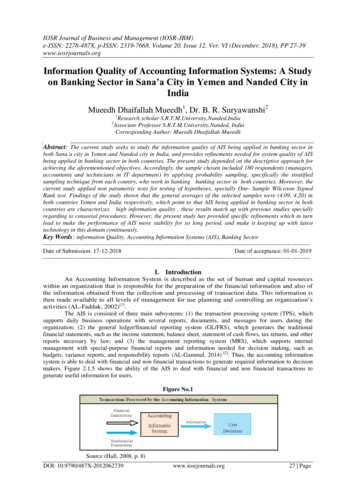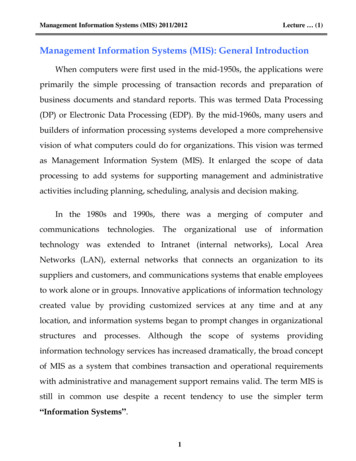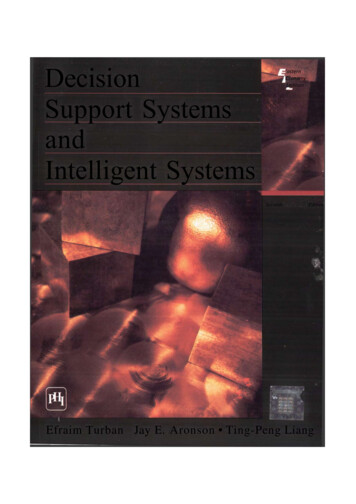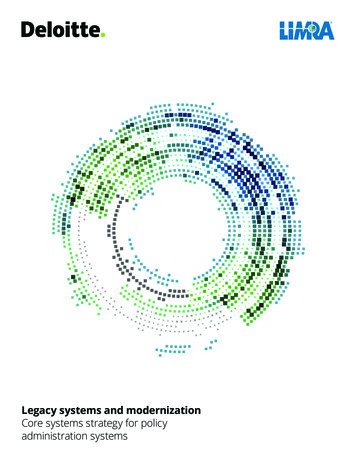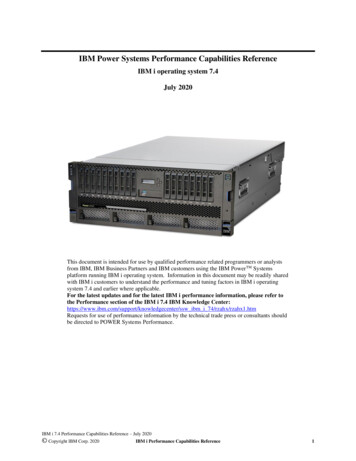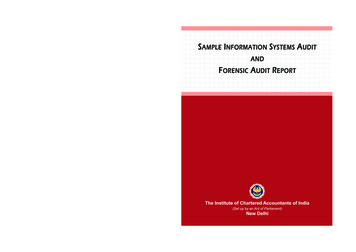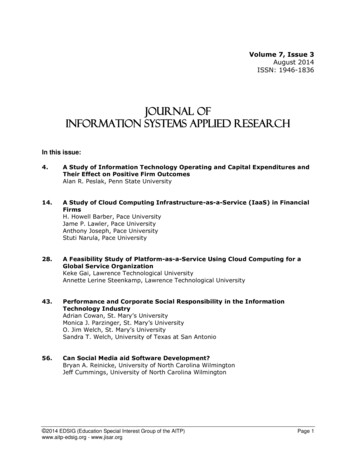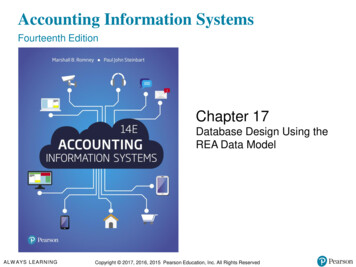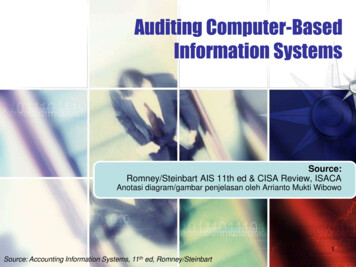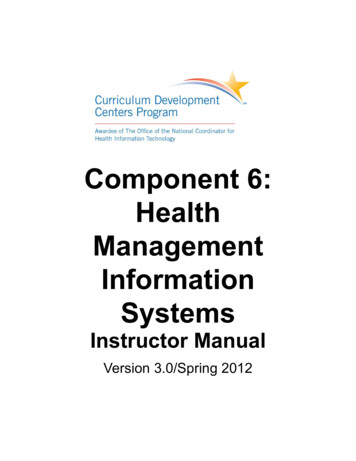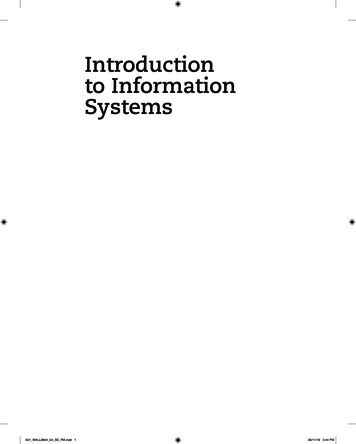
Transcription
Introductionto InformationSystemsA01 WALL9844 04 SE FM.indd 126/11/19 3:44 PM
A01 WALL9844 04 SE FM.indd 226/11/19 3:44 PM
Introductionto InformationSystemsFourth EditionPatricia WallaceJohns Hopkins UniversityA01 WALL9844 04 SE FM.indd 326/11/19 3:44 PM
Director of Product Management: Linea RoweProduct Management Lead, IT/MIS: Marcus SchererProduct Manager, IT/MIS: Becca GoldenSenior Analyst, HE Global Content Strategy,IT/MIS: Allie D’AprileAnalyst, HE Global Content, Careers &Professional: Bridget DalyManager Content HE, Careers & Professional: Jenifer NilesDirector, Digital Studio & Content Production: Brian HylandDigital Producer: Tanika HendersonSenior Digital Producer: Jaimie NoyManaging Content Producer: Jennifer SargunarContent Producer (Team Lead): Faraz Sharique AliAssistant Content Producer: Rudrani MukherjeeManager, Rights & Permission, HigherEducation: Annette LinderCover Designer: SPi GlobalCover Photo: Khanthachai C/Shutterstock, D mitry Kalinovsky/Shutterstock, Mark Nazh/Shutterstock, andreynikolaev.com/Shutterstock, and Jose Luis Stephens/EyeEm/Getty imagesFull-Service Project Management: Integra SoftwareServices Pvt. Ltd.Full-Service Project Manager: Gowthaman SadhanandhamManufacturing Buyer: LSC CommunicationsText Printer/Bindery: LSC CommunicationsCover Printer: Phoenix ColorText Font: 9.5/13 PalatinoLT Pro RomanCredits and acknowledgments borrowed from other sources and reproduced, with permission, in this textbook appear on theappropriate page within text.Microsoft and/or its respective suppliers make no representations about the suitability of the information contained in thedocuments and related graphics published as part of the services for any purpose. All such documents and related graphics areprovided “as is” without warranty of any kind. Microsoft and/or its respective suppliers hereby disclaim all warranties andconditions with regard to this information, including all warranties and conditions of merchantability, whether express, impliedor statutory, fitness for a particular purpose, title and non-infringement. In no event shall Microsoft and/or its r espective suppliers be liable for any special, indirect or consequential damages or any damages whatsoever resulting from loss of use,data or profits, whether in an action of contract, negligence or other tortious action, arising out of or in connection with the useor performance of information available from the services.The documents and related graphics contained herein could include technical inaccuracies or typographical errors. Changes are periodically added to the information herein. Microsoft and/or its respective suppliers may make improvementsand/or changes in the product(s) and/or the program(s) described herein at any time. Partial screen shots may be viewed in fullwithin the software version specified.Microsoft and Windows , and Microsoft Office are registered trademarks of the Microsoft Corporation in the U.S.A. andother countries. This book is not sponsored or endorsed by or affiliated with the Microsoft Corporation.Copyright 2021, 2018, 2015, 2013 by Pearson Education, Inc., All rights reserved. Manufactured in the United States of America. This publication is protected by Copyright, and permission should be obtained from the publisher prior to anyprohibited reproduction, storage in a retrieval system, or transmission in any form or by any means, electronic, mechanical,photocopying, recording, or likewise. To obtain permission(s) to use material from this work, please submit a written requestto Pearson Education, Inc., Permissions Department, One Lake Street, Upper Saddle River, New Jersey 07458, or you may faxyour request to 201-236-3290.Many of the designations by manufacturers and sellers to distinguish their products are claimed as trademarks. Where thosedesignations appear in this book, and the publisher was aware of a trademark claim, the designations have been printedin initial caps or all caps.Library of Congress Cataloging-in-Publication DataOn file with the Library of Congress.ScoutAutomatedPrintCodeISBN 10: 0-13-582984-4ISBN 13: 978-0-13-582984-4A01 WALL9844 04 SE FM.indd 426/11/19 3:44 PM
To Julian, Callie, Eric, and Julian, and a bright futureof human–centered computing.A01 WALL9844 04 SE FM.indd 526/11/19 3:44 PM
A01 WALL9844 04 SE FM.indd 626/11/19 3:44 PM
About the AuthorPatricia Wallace’s career spans the fields of information technology, business andmanagement, and psychology, and she has held varied positions, including head ofinformation technology, faculty member, academic administrator, and consultant.She recently retired from Johns Hopkins University, where she was Senior Director,IT and Online Programs, at the Center for Talented Youth for 14 years. Before joiningHopkins, Dr. Wallace served as Chief, Information Strategies, at the Robert H. SmithSchool of Business, University of Maryland, College Park. She teaches in the GraduateSchool of the University of Maryland University College, where she also served asthe Associate Vice President and Chief Information Officer for ten years. She earnedher Ph.D. in Psychology at the University of Texas at Austin and holds an M.S. inComputer Systems Management. Dr. Wallace has published 15 books, includingThe Internet in the Workplace: How New Technologies Transform Work (2004) and The Psychology of the Internet (2016), several educational software programs, and numerousscholarly articles.viiA01 WALL9844 04 SE FM.indd 726/11/19 3:44 PM
A01 WALL9844 04 SE FM.indd 826/11/19 3:44 PM
Brief Contents1Information Systems and People 12Information Systems and Strategy 303Information and Communications Technologies: The Enterprise Architecture 604Databases and Data Warehouses 925Information Systems for the Enterprise 1276Developing a Digital Presence: Websites, Social Media, and Mobile Apps 1617Business Intelligence and Analytics 1948Collaborating with Technology 2259Knowledge Management and E -Learning 25610Ethics, Privacy, and Security 28911Systems Development and Procurement 32312Information Systems Project Management and Strategic Planning 353Case Studies 384Glossary 397Index 405ixA01 WALL9844 04 SE FM.indd 926/11/19 3:44 PM
A01 WALL9844 04 SE FM.indd 1026/11/19 3:44 PM
ContentsAbout the Author viiPreface xix1Information Systems and People 1Learning Objectives 1Introduction 1Information Systems in ActionManaging OperationsSupporting Customer InteractionsMaking DecisionsCollaborating on TeamsGaining Competitive AdvantageImproving Individual ProductivityThe Nature of InformationData, Information, and KnowledgeWhat Makes Information Valuable?The Components of an Information SystemPeopleTechnologyProcessesDataInformation Systems, the DisciplineInformation Systems Throughout the OrganizationInformation Systems in BusinessInformation Systems in Nonprofits and GovernmentInside the IT DepartmentCollaborating on Information SystemsImproving Your Own ProductivityPromises, Perils, and Ethical Issues224456677899910121315151516171919THE ETHICAL FACTOR: Ethical Issues Surrounding Information Systems21INTERACTIVE SIMULATION: THE WORLD OF MAMMALS A Role-PlayingSimulation on Choosing a New CIO for an Animal Preserve21Chapter 1 Summary21Key Terms and Concepts 22Chapter Review Questions 22Projects and Discussion Questions 23Application ExercisesExcel: Staff Planning Spreadsheet24Access: Information Systems in Business25E-Projects282. Gathering, Visualizing, and Evaluating Reports from Twitter andOther Sources During a Disaster 2830Introduction 30Porter’s Five Competitive ForcesThreat of New EntrantsPower of BuyersPower of SuppliersThreat of SubstitutesRivalry among Existing Competitors313233343435Factors That Affect How the Five Forces OperateDisruptive Technology and InnovationsGovernment Policies and ActionsComplementary Services and Products in theEcosystemEnvironmental Events and “Wildcards”The Value Chain and Strategic ThinkingExtending the Value Chain: from Suppliers to theFirm to CustomersBenchmarking Components of the Value ChainIT Benchmarks363638Competitive Strategies in BusinessThe Role of Information Systems in StrategyInformation Systems: Run, Grow, and Transform theBusiness444539394040424246Information Strategies and Nonprofit Organizations48Fund-RaisingVolunteeringInformation Strategies and Government484849INCREASING ACCESS AND ENHANCING SERVICES TOTHE PUBLIC 49 FUNDING RESEARCH FOR TECHNOLOGICALINNOVATION 50Does IT Matter?Spending on Running, Growing, and TransformingLeveling UP!: A Strategic Analysis505151THE ETHICAL FACTOR: Ethical Responsibility in an ExtendedValue Chain42INTERACTIVE SIMULATION: LEVELING UP! A Role-Playing Simulationon Business Strategy for a New Smartphone App5252Chapter Review Questions2. Breaking News: Twitter’s Growing Role in Emergencies andDisaster Communications 2630Learning Objectives Key Terms and Concepts1. Trading at the Speed of Light: Nasdaq’s Information Challenges 25Endnotes 29Information Systems and StrategyChapter 2 SummaryCase Studies1. Analyzing the May 6 “Flash Crash” with Excel Charts25353Projects and Discussion Questions54Application ExercisesExcel: IT Benchmarks55Access: Telethon Call Reports55Case Studies1. Can GameStop Survive with Its Brick-and-Mortar Stores?2. The Battle over Net Neutrality5657xiA01 WALL9844 04 SE FM.indd 1126/11/19 3:44 PM
xii ContentsE-ProjectsE-Projects1. Identifying Company Strategy with Online Financial ChartTools 582. Analyzing Media Download Times with ExcelEndnotes31. Voluntary Distributed Computing58Endnotes584Information and CommunicationsTechnologies: The EnterpriseArchitecture6060Introduction 60The HardwareInput and Output6161HUMAN INPUT 61 SCANNERS AND SENSORS 63 OUTPUT DEVICES 64ProcessingStorage6566PRIMARY STORAGE 66 SECONDARY STORAGE 66The SoftwareTypes of SoftwareHow Is Software Created?676769PROGRAMMING LANGUAGES AND DEVELOPMENTENVIRONMENTS 69 SOFTWARE DEVELOPMENT ANDDEPLOYMENT STRATEGIES 70 OPEN SOURCE SOFTWARE 70Networks and TelecommunicationsTransmission Media and Protocols7171WIRED MEDIA 71 WIRELESS MEDIA 72Networking Basics73Network Protocols75ETHERNET 75 TCP/IP AND THE INTERNET’S HOURGLASSARCHITECTURE 76 WIRELESS PROTOCOLS 7677THE WIRELESS SPECTRUM AS OCEANFRONT PROPERTY 77 THE LAST MILE 77 CORD CUTTING 77The Enterprise ArchitectureTrends in Enterprise Architectures7878FROM MAINFRAMES TO MICROCOMPUTERS 78 CLIENT-SERVER ARCHITECTURES 78 THINCLIENTS 79 VIRTUALIZATION 79 INTEGRATION OFVOICE AND DATA 80 CLOUD COMPUTING 808266INTERACTIVE SIMULATION: RIVERSIDE LODGE A Role-PlayingSimulation on Enterprise Architecture for a River Resort8384Key Terms and Concepts 85Chapter Review Questions 85Projects and Discussion Questions 86Application Exercises1. Dropbox and the Personal Cloud2. The Race to 5GA01 WALL9844 04 SE FM.indd 12888792939394THE QUALITY OF INFORMATION 94Managing Information: from Filing Cabinets tothe DatabaseTables, Records, and FieldsThe Rise and Fall of File Processing Systems969697DATA REDUNDANCY AND INCONSISTENCY 97 LACK OFDATA INTEGRATION 98 INCONSISTENT DATADEFINITIONS 98 DATA DEPENDENCE 99Databases and Database Management Systems99DATABASE ARCHITECTURE 99 THE RELATIONAL DATABASE 100Developing and Managing a Relational Database Planning the Data Model101101ENTITIES AND ATTRIBUTES 101 PRIMARY KEYSAND UNIQUENESS 101 NORMALIZING THE DATAMODEL 102 RELATIONSHIPS AND FOREIGNKEYS 103 HANDLING COMPLEX RELATIONSHIPS 104105SQL: STRUCTURED QUERY LANGUAGE 106 OTHERACCESS AND RETRIEVAL TOOLS 107 NATURAL LANGUAGEINTERFACES 107108PERFORMANCE TUNING AND SCALABILITY 108 INTEGRITY,SECURITY, AND RECOVERY 109 DOCUMENTATION 109Data Warehouses and Big DataIntegrating Information with a Data Warehouse109110SOURCES OF DATA FOR THE DATA WAREHOUSE 110 BUILDING THE DATA WAREHOUSE 111112WHAT IS BIG DATA? 112 BIG DATA TECHNOLOGIES 113THE ETHICAL FACTOR: Ethical Implications of Big DataCase StudiesThe Nature of Information ResourcesStructured, Unstructured, and SemistructuredInformationMetadataThe Challenge of Big DataGuiding the Enterprise Architecture8792Introduction 92Managing and Maintaining the DatabaseStrategy and Competition in TelecommunicationsAccess: Managing ICT Assets with a DatabaseDatabases and Data WarehousesAccessing the Database and Retrieving InformationPACKET SWITCHING 73 CLIENT-SERVER AND PEER-TOPEER NETWORKS 74Excel: Analyzing Growth in Computer Storage Capacities9090Learning Objectives Learning Objectives Chapter 3 Summary892. Analyzing Costs for Software as a Service (SaaS)87Distributed Databases and BlockchainDistributed Database ArchitecturesBlockchain114114114The Challenges of Information Management:The Human ElementOwnership IssuesShadow SystemsMaster Data ManagementDatabases without BoundariesBalancing Stakeholders’ Information Needs115115115115116116THE ETHICAL FACTOR: Ethical Issues in Database Design:The Case of Race and Ethnicity106INTERACTIVE SIMULATION: VOLUNTEER NOW! A Role-PlayingSimulation on Designing the Database for aVolunteer-Matching Service11726/11/19 3:44 PM
xiiiContentsChapter 4 Summary117Key Terms and ConceptsEnterprise Resource Planning (ERP): Bringing It AllTogetherERP Components118Chapter Review Questions119Projects and Discussion Q uestionsSTUDENT’S VIEW OF THE ERP 147 THE FACULTY’S VIEWOF THE ERP 149119Application ExercisesExcel: Managing Catering SuppliesAccess: DD-DesignsERP Integration Strategies1201211. UK Police Track Suspicious Vehicles in RealTime with Cameras and the License Plate DatabaseImplementation Issues1221231. Identifying Suspects with a License Plate Database: Constructing Queries with Access 1242. Building a Database for Customer Records5124125Information Systems forthe Enterprise127Learning Objectives 127Introduction 127Finance ManagementComponents of Financial Information Systems128128INTEGRATING THE COMPONENTS 128 FINANCIALWORKFLOWS 129Financial Reporting, Compliance, and Transparency130Managing the Supply ChainSupply Chain Fundamentals132132133134134136SUPPLY CHAIN VISIBILITY 136 SUPPLY CHAINMETRICS 136 REDUCING SUPPLY CHAIN COSTS 137 SUPPLY CHAIN DISRUPTIONS 137Information Systems and Technology for SupplyChain Management1381411421562. Meeting Demands of Global Growth, Netflix Migrates to Integrated ERP 157E-Projects1582. Evaluating Employment and Recruitment Websites6159159Developing a Digital Presence:Websites, Social Media, andMobile Apps143161161Introduction 161Developing a Digital StrategyChoosing a Goal162162INFORM OR ENTERTAIN THE AUDIENCE 162 INFLUENCETHE AUDIENCE 163 SELL PRODUCTS ANDSERVICES 163 FACILITATE OFFLINE RELATIONSHIPS 163Social Media Goals164164165COMPONENTS OF A URL 165 MANAGING DOMAIN NAMESAND VIRTUAL REAL ESTATE 166 DISPUTES OVER DOMAINNAMES 166167WEBSITE INFORMATION ARCHITECTURE ANDNAVIGATION 167 USABILITY AND USER INTERFACEDESIGN 169 WEB ACCESSIBILITY FOR PEOPLE WITHDISABILITIES 169Software Development Strategies for the WebMARKETING 144 SALES FORCE AUTOMATION 145 CUSTOMER SERVICE AND SUPPORT 145 MOBILE CRM 146A01 WALL9844 04 SE FM.indd 131. Salesforce.com: Taking CRM to the CloudWebsite DesignIMPROVING CUSTOMER RETENTION 142 IMPROVINGPROFITABILITY 142 GROWING REVENUE 142 LISTENING TO CUSTOMERS 143CRM Strategies and Technologies152Chapter 5 Summary 152Key Terms and Concepts 153Chapter Review Questions 153Projects and Discussion Questions 154Application ExercisesExcel: Performance Bicycle Parts 154Access: VSI Consultants 155Case StudiesBuilding the WebsiteThe Website’s Name and Virtual AddressSUPPLY CHAIN COLLABORATION: ELECTRONIC DATAINTERCHANGE AND BLOCKCHAIN 138 SUPPLY CHAINAND THE INTERNET OF THINGS 139Customer Relationship ManagementCRM Goals and MetricsINTERACTIVE SIMULATION: CUSTOM CAKES A Role-Playing Simulationon Enterprise Information Systems and the Supply ChainLearning Objectives THE PLANNING STEP 134 CHOOSING SOURCES 135 MAKE, DELIVER, RETURN 135Measuring Performance in Supply Chains135EndnotesHUMAN RESOURCES MANAGEMENT 132 WORKFORCEMANAGEMENT 132 TALENT MANAGEMENT 132 SOCIALNETWORKING AND HCM 133HCM MetricsTHE ETHICAL FACTOR: Ethics and Talent Management 1. CRM for Human Services AgenciesEXCEPTION REPORTING 131 COMPLIANCE REPORTING 131 XBRL 131 IMPROVING TRANSPARENCY 131Human Capital ManagementComponents of Human Capital ManagementSystems150ERPs AND SOFTWARE AS A SERVICE (SAAS) 151 ERP PROS AND CONS 151E-ProjectsEndnotes149MAKING CONNECTIONS WITH MIDDLEWARE 150 PROS ANDCONS OF DIFFERENT INTEGRATION STRATEGIES 150Case Studies2. Walmart Deploys Blockchain for Food Safety147147171HTML AND HTML 5 172 CREATING INTERACTIVE, MEDIA-RICHWEBSITES 173 CONTENT MANAGEMENT SYSTEMS 174E-CommerceThe Online Transaction and E-Commerce Software17517526/11/19 3:44 PM
xiv ContentsE-Commerce SecurityE-Commerce Trust176176AnalyticsAnalyzing Patterns, Trends, and RelationshipsONLINE ANALYTICAL PROCESSING (OLAP) 201 STATISTICSAND MODELING TECHNIQUES 203 TEXT ANALYTICS 203Mobile Devices and M-CommerceWhy Mobile MattersDesigning for Mobile DevicesM-Commerce and Mobile Payments177177177178Simulating, Optimizing, and ForecastingDigital MarketingSearch Engine Optimization179179Artificial Intelligence and Augmented Analytics SEARCH TERMS AND KEYWORDS 179 PAGERANK ANDRELEVANCE 179 SEARCH ENGINE SCAMS 179 ONLINEADVERTISING AND COOKIES 180 SEARCH ENGINEADVERTISING 181Social and Mobile Marketing182183183184THE ETHICAL FACTOR: Website Accessibility: Why Is ProgressSo Slow?170INTERACTIVE SIMULATION: CRUISIN’ FUSION A Role-Playing Simulationon Website Development for a Chain of Concession Stands185185Key Terms and Concepts 186Chapter Review Questions 187188199INTERACTIVE SIMULATION: CHOCOLATE LOVERS UNITE A Role-PlayingSimulation on Business Intelligence and Analytics217217218218219 Access: Marketing City Hospital Seminars 220189Case Studies1. Cracking Fraud with Government’s Big Data and AI1. Examining Top M-Commerce Sites1912. Exploring LinkedIn’s Web Analytics192Learning Objectives 222E-Projects1. Detecting Suspicious Activity in Insurance Claims2. Analyzing TV Ratings with Excel192Business Intelligence and Analytics2202. TV and Social Media: Nielsen’s Social Content RatingsE-Projects7THE ETHICAL FACTOR: Ethics and Bias in Artificial Intelligence Excel: Analyzing Revenue and Expenses for City Hospital Seminars 2191892. LinkedIn: The Social Network and E-Marketplacefor Professionals 190Endnotes213213214215216Application ExercisesCase Studies1. Mobile PaymentsPutting It All Together: Dashboards, Portals, and MashupsDashboardsPortalsMashupsBusiness Intelligence: The Human ElementProjects and Discussion QuestionsWebsite: Heritage Dogs 188211ANALYTICS SOFTWARE 212 REACHING GOALS ANDMEASURING SUCCESS 212Chapter Review QuestionsApplication ExercisesAccess: Springfield Animal ShelterAnalyzing Data and Achieving Success Key Terms and ConceptsProjects and Discussion Q uestions 187208209WEBSITE METRICS 209 SOCIAL MEDIAMETRICS 209 E-COMMERCE AND ADVERTISINGMETRICS 210 MOBILE METRICS 210Chapter 7 Chapter SummaryExcel: Heritage Dogs Website Metrics205EXPERT SYSTEMS 207 NEURAL NETWORKS 207 COMPUTER VISION 208Achieving Success with Digital AnalyticsCapturing Digital MetricsSOCIAL MARKETING STRATEGIES 181 MOBILE MARKETINGSTRATEGIES 181Chapter 6 Chapter Summary204WHAT-IF ANALYSIS 204 GOAL SEEKING 204 OPTIMIZING 205 FORECASTING 205181The Evolving Digital EnvironmentCrowdsourcing and Collective IntelligenceExpanding Data and Sensory Input:The Internet of ThingsAlways g with TechnologyLearning Objectives 225225Introduction 194Introduction 225Levels of Decision MakingOperational LevelTactical LevelStrategic Level195195196196The Evolution of Collaborative TechnologiesEmail Technology, Contacts, and CalendarsSources of Business IntelligenceTransactional Databases, Data Warehouses,and Internal Data SourcesExternal Data Sources and Big Data197INTELLIGENT AGENTS 198 BI AND BIG DATA 199A01 WALL9844 04 SE FM.indd 14197198226226THE ADDRESS BOOK, BUSINESS CARDS, AND CONTACTMANAGEMENT 227 CALENDARS AND TIMEMANAGEMENT 228Discussion ForumsInstant Messaging and Texting228229PRESENCE AWARENESS 229 TEXT MESSAGING ORTEXTING 229 THE CHALLENGES OF INTEROPERABILITY 231 GROUP CONVERSATION SOFTWARE 23126/11/19 3:44 PM
ContentsGroup Decision Support Systems (GDSS)Web ConferencingInteractive VideoShared Workspaces232232233234Web 2.0 Collaborative TechnologiesBlogsWikisSocial NetworkingMicrobloggingVirtual Worlds, Virtual Reality, and Augmented Reality235235236236238239Unified CommunicationsCapabilities for Unified CommunicationsUniversal Dashboards241241242The Human Element and Collaborative TechnologiesCharacteristics of Online Environments242242UNFAMILIAR TOOLS AND LEARNING CURVES 243 MEDIA RICHNESS 243 PHYSICAL DISTANCE 243 ANONYMITY 243 AUDIENCE 245Managing Online ImpressionsGroup Dynamics in Virtual TeamsMaking Virtual Teams Work245245247THE ETHICAL FACTOR: Flash Mobs and Free Speech:Should Police Block Mobile Messaging Services? 244INTERACTIVE SIMULATION: DEPARTMENT OF SOCIAL SERVICESA Role-Playing Simulation on Collaborative Technologiesand Virtual Teamwork248Chapter 8 Chapter Summary248Key Terms and Concepts249Chapter Review Question249Projects and Discussion Q uestions 249Excel: Going Green!250Case Studies1. Telepresence Robots Support Remote Collaboration251252E-Projects1. Estimating Breakeven Pricing for Telepresence RobotsUsing a Spreadsheet 2539262BUILDING A KNOWLEDGE BASE FOR STRUCTURALCAPITAL 262 STRATEGIES FOR CAPTURING TACITKNOWLEDGE 263Organize, Share, and Value Knowledge264ORGANIZING AND SHARING STRATEGIES 264 DECIDINGWHAT TO KEEP: VALUATION STRATEGIES 266Knowledge Management: Pitfalls and PromisesThe Human Element: Why Share Knowledge?Incentives for Knowledge SharingTechnology Hurdles and Content IssuesThe Semantic WebPractical Tips for Launching a KnowledgeManagement Project266267268269269E-LearningTypes of E-Learning Approaches270270269SELF-PACED E-LEARNING 270 INSTRUCTOR-LEDE-LEARNING 271 HYBRID PROGRAMS 272Corporate and Educational E-Learning ApproachesCreating an E-Learning ProgramCourse DevelopmentLearning ObjectsContent Authoring ToolsCollaboration ToolsStrategies to Prevent CheatingLearning Management Systems272273273274275276277278268INTERACTIVE SIMULATION: CRIMINAL INVESTIGATIONS DIVISIONA Role-Playing Simulation on Knowledge Management forCrime Scene Police Work281Key Terms and Concepts281282Chapter Review Questions254279279THE ETHICAL FACTOR: Knowledge Sharing in Fast-PacedIndustries: The Case of Formula One Racing Chapter 9 Chapter Summary2. Estimating Savings for Virtual Work Using anExcel Model 254EndnotesFINDING EXPERTISE 260 SOCIAL NETWORK ANALYSIS 261Capture the KnowledgeLearning AnalyticsComparing E-Learning and Classroom Learning2512. The Pros and Cons of Telecommuting259259260LEARNING OBJECTS, ASSESSMENTS, ANDSTANDARDS 278 SOCIAL LEARNING PLATFORMS 278Application Exercises Access: Cloud 9Knowledge Management Strategies and TechnologiesIdentify the GoalLocate the Sourcesxv283Projects and Discussion Questions283Application ExercisesKnowledge Managementand E-LearningLearning Objectives Excel: Top Talent 284256256Access: Top Talent 284Case StudiesIntroduction 2561. From Lynda.com to LinkedIn Learning: The Evolution ofE-Learning for Business 284The Nature of Intellectual CapitalTypes of Intellectual Capital2. Diplopedia: Managing State Department Knowledge witha Wiki 285257257HUMAN CAPITAL 257 SOCIAL CAPITAL 257 STRUCTURALCAPITAL 257Types of Knowledge1. Exploring the World of Online Courses258EXPLICIT KNOWLEDGE 258 TACIT KNOWLEDGE 258Managing Intellectual CapitalA01 WALL9844 04 SE FM.indd 15E-Projects2582872. Managing the Human Element on Wikipedia with Technology 287Endnotes28726/11/19 3:44 PM
xvi Contents10Ethics, Privacy, and SecurityLearning Objectives 289289Introduction 289EthicsEthical FrameworksEthics and the LawEthical Issues and Information and CommunicationsTechnologies290290290Information EthicsIntellectual Property and Digital Rights Management292293291ENFORCING IP LAWS 293 PIRACY 293 PROTECTINGIP WITH TECHNOLOGY 294Plagiarism294PrivacyTrading Privacy for Convenience and FreebiesAnonymitySurveillance“The Right to Be Forgotten”Information SecurityRisk ManagementIdentifying Threats296297297299300300301301MALWARE AND BOTNETS 301 DISTRIBUTED DENIAL OFSERVICE 302 PHISHING 302 RANSOMWARE 304 INFORMATION LEAKAGE 304Assessing VulnerabilityAdministrative Security ControlsTechnical Security Controls305306306AUTHENTICATION STRATEGIES 307 ENCRYPTION 308 INTRUSION PREVENTION AND DETECTION SYSTEMS 308 FIREWALLS 309 BLOCKING SPAM 309Information Security and Cloud ComputingThe Human Element in Information Ethics, Security,and PrivacyCognitive Issues and Productivity309311311AVOIDING WEAK PASSWORDS 311 REDUCINGCOMPLEXITY 311Social Engineering and Information SecuritySecurity Awareness and Ethical Decision Making312313THE ETHICAL FACTOR: Ethical Dilemmas in a Distributed Denialof Service Attack 304INTERACTIVE SIMULATION: VAMPIRE LEGENDS A Role-PlayingSimulation on Ethics, Privacy, and Security in theMultiplayer Online Game Business314Chapter 10 Chapter Summary314Key Terms and Concepts 315Chapter Review Questions 315Projects and Discussion Q uestions 316Application ExercisesExcel: Citywide Community College317Access: Citywide Community College 317Case Studies1. Equifax: A Massive Data Breach at a Consumer ReportingAgency 3182. Community Policing on the Internet: Spamhaus Targets Worldwide Spammers 319A01 WALL9844 04 SE FM.indd 16E-Projects1. Tracking the Trackers: Investigating How Third-Party CookiesSteer the Ads You See 3202. Who Are the Spammers?Endnotes11321321Systems Developmentand ProcurementLearning Objectives 323323Introduction 323Systems Development Life CyclePlanning324324ASSESSING BUSINESS NEED 324 FEASIBILITY STUDY 325Analysis325PROCESS DIAGRAMS AND BUSINESS PROCESSIMPROVEMENT 325 REQUIREMENTS DEFINITIONDOCUMENT 326 BUILD OR BUY? 327Design Phase327ARCHITECTURAL DESIGN 327 SERVICE-ORIENTEDARCHITECTURE 328 APPLICATION PROGRAMMINGINTERFACES (API) 328 DATA MODELS AND DATABASEDESIGN 329Development PhasesTesting PhaseImplementationMaintenance329331331333BUG FIXES AND CHANGE REQUESTS 333 WHENINFORMATION SYSTEMS GROW OLD 334Software Development StrategiesWaterfall Software DevelopmentIterative MethodsAgile Methods334335336336SCRUM 337 EXTREME PROGRAMMING (XP) 337Comparing Software Development ApproachesType of ProjectOrganizational CultureIs Waterfall Dead?Global Software DevelopmentSoftware Procurement: The “Buy” StrategyPros and Cons of Build and BuyThe Procurement Process338338338339339340340340RFI AND RFP 340 EVALUATING THE OPTIONS 341Adaptation and Customization342The Human Element in SystemsDevelopment and ProcurementWorking in TeamsWorking with Consultants343343343ADVANTAGES AND DISADVANTAGES 343 CONTRACTMANAGEMENT 344The Role of Senior Management344THE ETHICAL FACTOR: Developing Systems That PromoteEthical Decision Making and Social Responsibility 336INTERACTIVE SIMULATION: GREEN WHEELING A Role-PlayingSimulation on Systems Development andProcurement34526/11/19 3:44 PM
xviiContentsChapter 11 Chapter Summary 345FUNDING MODELS FOR IT 364 ACCEPTABLE-USE ANDSECURITY POLICIES 365 RECORD RETENTIONPOLICIES 366 ENTERPRISE ARCHITECTURE 367Key Terms and Concepts 346Chapter Review Questions 347Project Portfolio ManagementProjects and Discussion Questions 347Application ExercisesExcel: Jay’s Bikes348Disaster Recovery and Business Continuity PlanningTechnology and Industry TrendsAccess: Managing a Recipe Collection 348Case Studies1. Baby Steps toward Scrum: How BabyCenter.comMade the Cultural Transition to Agile Software Development 3492. Extreme Programming at the US Strategic Command350E-Projects1. Watching Babycenter.com Change over Time with theInternet Archive 3512. Analyzing Software Defect Rates Using ExcelEndnotes371371373THE ETHICAL FACTOR: Code of Ethics for Project Managers 360INTERACTIVE SIMULATION: EXTREME VIRTUAL REALITY A Role-PlayingSimulation on Managing a Project to Open a New Business374Chapter 12 Chapter Summary351Key Terms and Concepts352Information Systems ProjectManagement and StrategicPlanningLearning Objectives 369370Planning for the Future: the Human ElementCognitive Biases and Strategic PlanningThe Black SwanChapter Review Questions375376376Projects and Discussion Questions12367DECIDING WHICH PROJECTS TO PURSUE 367 MANAGINGTHE PORTFOLIO 368376Application ExercisesExcel: Creating a Gantt Chart with Excel353353Introduction 353What Is a Project?Projects versus ProcessesThe Triple Constraint: Time, Cost, and Scope354354355Project ManagementThe Five Project Management Processes355356INITIATING 356 PLANNING 357 EXECUTING 358 MONITORING AND CONTROLLING 359 CLOSING 359Access: Apprentice Project Managers377378Case Studies1. Predicting the Future: Gartner’s Research Informs Strategic Planning 3792. JetBlue and WestJet: A Tale of Two Software Implementations 381E-Projects1. Examining an IT Strategic Plan3822. Analyzing Airline Performance with Excel Pivot Tables 382Endnotes382Comprehensive Case Studies1. Facebook’s Privacy Challenges 3842. Enabling the Sharing Economy: The Case ofUber Technologies 3883. Apple: Can the Company Pull off AnotherDisruptive Innovation? 3914. Managing the Federal Government’s IT ProjectPortfolio 394The Role of the Project Manager359Project Management SoftwareManaging TimeManaging People and ResourcesManaging Costs360360361361Why Projects Succeed and Why They FailWhy Do Projects Fail?Success Factors for Project Management362362363Case Studies Strategic Planning for Information SystemsVision, Principles, and Policies364364Glossary 397Index 405A01 WALL9844 04 SE FM.indd 1738426/11/19 3:44 PM
A01 WALL9844 04 SE FM.indd 1826/11/19 3:44 PM
PrefaceContent Updates andChanges
ix Brief Contents 1Inform ation Systems and People 1 2Information Systems and Strategy 30 3Information and Communications Technologies: The Enterprise Architecture 60 4Databases and Data Warehouses 92 5Information Systems for the Enterprise 127 6Developing a Digital Presence: Websites, Social Media, a
